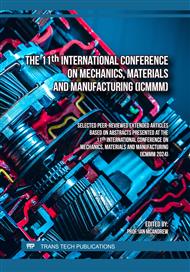[1]
B. H. Benameur, Dynamic Response Of Hull Due, ProQuest LLC, 1995, pp.31-32.
Google Scholar
[2]
D.P. Townsend, Comportamiento A Impacto De Materiales Compuestos Sometidos A Fenómenos De Slamming En Embarcaciones De Alta Velocidad., Madrid: Universidad Poilectnica de Madrid, 2018.
DOI: 10.20868/upm.thesis.52439
Google Scholar
[3]
R.P. Fernández, «Construcción Naval: innovación y sostenibilidad,» MAPFRE Global Risks, p.1, 14 Septiembre 2021.
Google Scholar
[4]
P. Townsend, J. C. Suárez-Bermejo, P. Pinilla y N. Muñoz, «Insertion of viscoelastic layer to absorb the propagation of energy due to vertical slamming impacts in fiberglass reinforced plastic vessel,» Ingeniare. Rev. chil. ing., vol. 30, nº 2, pp.289-305, 2022.
DOI: 10.4067/s0718-33052022000200289
Google Scholar
[5]
ABS, Slamming Loads And Strength Assessment For., New York: American Bureau of Shipping, 2021, pp.8-9.
Google Scholar
[6]
J.C. S. B. Patricio Townsend y &. Rodríguez-Ortíz, « Analysis of Hybrid Viscoelastic Sheets Adhered to the Hull of a GFRP Vessel to Reduce Impact Damage,» Agarwal, R.K. (eds) Recent Advances in Manufacturing Engineering and Processes, pp.159-166, 01 Febrero 2023.
DOI: 10.1007/978-981-19-6841-9_16
Google Scholar
[7]
X. Martinez, S. Oller y E. Barbero, «Caracterización de la delaminación en materiales compuestos mediante la teoría de mezclas serie/paralelo,» Revista Internacional de Métodos Numéricos para Cálculo y Diseño en Ingeniería, vol. 27, nº 3, pp.189-199, 2011.
DOI: 10.1016/j.rimni.2011.07.001
Google Scholar
[8]
B.W. Kim y J. Nairn, «Observations of Fiber Fracture and Interfacial Debonding Phenomena Using the Fragmentation Test in Single Fiber Composites,» Journal of Composite Materials, vol. 36, pp.1825-1858, 2022.
DOI: 10.1177/0021998302036015243
Google Scholar
[9]
S.I. Dr. S. Selvaraju, «Aplications of composites in marine industry,» Journal of Engineering Research and Studies, vol. II, pp.89-91, 2011.
Google Scholar
[10]
2. A. Besednjak, Materiales compuestos Procesos de fabricación de embarcaciones, Barcelona: Edicions UPC, 2005.
DOI: 10.5821/ebook-9788498802108
Google Scholar
[11]
C.P. Alonso, Naval Composites: Los materiales compuestos y la industria naval, Barcelona: Universidad Politecnica de Calalunya, 2016.
Google Scholar
[12]
ASTM INTERNATIONAL, «Standard Test Method for Tensile Properties of Polymer Matrix Composite Materials».
Google Scholar
[13]
W.F. Smith, Fundamentos de la ciencia e ingeniería de materiales, 4th Edition, Mexico: McGRAW-HILL INTERAMERICANA EDITORES, S. A. DE C.V., 2006.
Google Scholar



